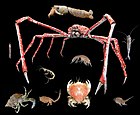端足类
| 端足目 化石时期:
| |
|---|---|
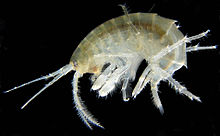
| |
| Gammarus roeseli | |
| 科学分类 | |
| 界: | 动物界 Animalia |
| 门: | 节肢动物门 Arthropoda |
| 亚门: | 甲壳亚门 Crustacea |
| 纲: | 软甲纲 Malacostraca |
| 亚纲: | 真软甲亚纲 Eumalacostraca |
| 总目: | 囊虾总目 Peracarida |
| 目: | 端足目 Amphipoda Latreille, 1816[1] |
| 亚目 | |
端足类(学名:Amphipoda),亦作片脚类,是一个没有甲壳及两侧扁平的目级甲壳类动物。其学名的意思是“不同的足”,是指它们拥有不同的附属肢形态。它们长1-340毫米不等,栖息在所有的水生环境及一些潮湿的陆生环境。当中有7000个物种,其中5500个被分类到钩虾亚目中,其余的则分到余下的二或三个亚目。
特征
[编辑]
端足类的身体共分13节,可以分类为头部、胸部及腹部。[2]头部与胸部融合,有两对触角及一对复眼。[3]头上亦有一个口器,不过大部分的口器都是隐藏的。[4]胸部及腹部各有不同,且有不类别的脚。它们一般都是两侧扁平的,且没有甲壳。[3]胸部有八对单肢附足,第一对是辅助口器的,其后四对向前,最后三对向后。[3]鳃位于胸节,循环系统是开放的,拥有心脏,血青蛋白在血淋巴中运送氧至身体组织。触角上有特别的腺来控制吸收及排出盐份。[2]腹部分为两部分:前尾有游泳肢,后尾有尾节及三对腹足,腹足并不会组成尾扇。[3]
端足类一般短于10毫米,但最长活生生的端足类可以达28厘米,是生活在太平洋5300米水深处的地方。[5]于大西洋发现的标本重组后就发现长达34厘米,属于Alicella gigantea的。[6]最细小的就只有1毫米长。[7]端足类的大小受到溶氧供应的限制,如在海拔3800米的的的喀喀湖中,端足类就可以生长达22毫米;而在海拔455米的贝加尔湖,其中的端足类就长达90毫米。[8]
繁殖及生命周期
[编辑]成熟的雌性有育幼袋,可以带着受精卵[2],直至幼体孵化为止。[3]雌性的年纪越大就会产更多的卵。卵的死亡率约为25–50%。[2]它们没有幼体阶段,卵会直接孵化出幼生。经过6次脱壳后,它们就达至性成熟。[2]一些物种在脱壳后会吃下自己的壳。[2]
多样性及分类
[编辑]卡尔·林奈在其第十版的《自然系统》(Systema Naturae)中描述了两种端足类,不过描述得十分简单且适用于差不多所有端足类。[9]现时约已描述了7000种端足类,分类在3或4个亚目中。钩虾亚目下就包含了多过5500种,包括了所有淡水及陆生物种。[4]英高虫亚目包含了2科约40种[10],但这类有时被认为是与钩虾亚目相同,而非独立的一个亚目。[4]
端足类因其体型细小而很难辨认,往往都需要将之解剖才能确认。生态及环境研究很多都会将它们混为一谈。[11]端足类的分类尚未得到共识,当中以钩虾亚目内的关系产生最多混乱。[12]以下是其中一个建议的分类法:[12]
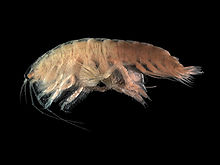
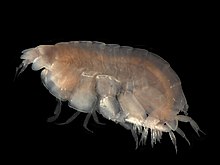
- 钩虾亚目(Gammaridea)
- Ampeliscoidea
- Crangonyctoidea
- Dexaminoidea
- Eusiroidea
- Gammaroidea
- Hadzioidea
- Iphimedioidea
- Kurioidea
- Leucothoidea
- Liljborgioidea
- 琴钩虾总科 Lysianassoidea
- Melphidippoidea
- Oedicerotoidea
- Pardaliscoidea
- Phoxocephaloidea
- Stegocephaloidea
- Stenothoidea
- Synopioidea
- Talitroidea
- Thurstonelloidea
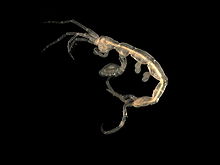
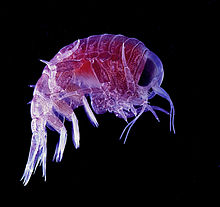
- 麦杆虫亚目(Caprellidea)
- Caprellida
- Caprelloidea
- Phtisicoidea
- Cyamida
- 鲸虱科(Cyamidae)
- 𧊕亚目(Hyperiidea)
- 体箱𧊕次目(Physosomata)
- 头箱𧊕次目(Physocephalata)
- 端足目包括以下科:
- Acanthogammaridae
- Acanthonotozomatidae
- Acanthonotozomellidae
- Acidostomatidae
- Adeliellidae
- Aetiopedesidae
- Alicellidae
- Allocrangonyctidae
- Amaryllididae
- Amathillopsidae
- Ambasiidae
- Ampeliscidae
- Amphilochidae
- Amphithyridae
- 藻钩虾科 Ampithoidae
- Anapronoidae
- 异钩虾科 Anisogammaridae
- Aoridae
- Archaeoscinidae
- Arcitalitridae
- Argissidae
- Aristiidae
- Artesiidae
- Astyridae
- Atylidae
- Australomicroprotopidae
- Austroniphargidae
- Baikalogammaridae
- Bateidae
- Bathyporeiidae
- Behningiellidae
- Bogidiellidae
- Bolttsiidae
- Bougisidae
- Brachyscelidae
- Brevitalitridae
- Calliopiidae
- 麦秆虫科 Caprellidae
- Caprellinoididae
- Caprogammaridae
- Carangoliopsidae
- Carinogammaridae
- Caspicolidae
- Cebocaridae
- Ceinidae
- Cheidae
- 强螯钩虾科 Cheirocratidae
- Cheluridae
- Chevaliidae
- Chillagoeidae
- Chiltoniidae
- Chuneolidae
- Colomastigidae
- Condukiidae
- Conicostomatidae
- Corophiidae
- Crangonyctidae
- Crangoweckeliidae
- Cressidae
- Crymostygidae
- Crypturopodidae
- Curiotalitridae
- 鲸虱科 Cyamidae
- Cyclocaridae
- Cyllopodidae
- Cyphocarididae
- Cyproideidae
- Cystisomatidae
- Dairellidae
- Derjugianidae
- Dexaminidae
- Didymocheliidae
- Dikwidae
- Dogielinotidae
- Dulichiidae
- Dussartiellidae
- Endevouridae
- Eophliantidae
- Epimeriidae
- Eriopisidae
- Eulimnogammaridae
- Eupronoidae
- Eurytheneidae
- Eusiridae
- Exoedicerotidae
- Falklandellidae
- Gamaridae
- Gammaracanthidae
- Gammarellidae
- 钩虾科 Gammaridae
- Gammaroporeiidae
- Giniphargidae
- Hadziidae
- Haustoriidae
- Hirondelleidae
- Hornelliidae
- Hyalellidae
- Hyalella S.I.Smith, 1874
- Hyallela troglofugia Bastos-Pereira, Oliveira & Ferreira, 2018
- Hyalella yashmara Tomikawa, Kawasaki, Leiva & Arroyo, 2023[13]
- Hyalella S.I.Smith, 1874
- Hyalidae
- Hyperiidae
- Hyperiopsidae
- Iciliidae
- Ingolfiellidae
- Ipanemidae
- Iphigenellidae
- Iphimediidae
- Isaeidae
- 壮角钩虾科 Ischyroceridae
- Iulopididae
- Izinkalidae
- Kairosidae
- Kamakidae
- Kergueleniidae
- Kergueleniolidae
- Kotumsaridae
- Kuriidae
- Lafystiidae
- Lanceolidae
- Laphystiopsidae
- Lepechinellidae
- Lepidepecreellidae
- Lestrigonidae
- Leucothoidae
- Liljeborgiidae
- Luciobliviidae
- Lycaeidae
- Lycaeopsidae
- 琴钩虾科 Lysianassidae
- Macrohectopidae
- Maeridae
- Magnovidae
- Makawidae
- Maxillipiidae
- Megalanceolidae
- Megaluropidae
- Melitidae
- Melphidippidae
- Mesogammaridae
- Metacrangonyctidae
- Metaingolfiellidae
- Metalanceolidae
- Microphasmidae
- Microprotopidae
- Microprotopodidae
- Microscinidae
- Micruropidae
- Micruropodidae
- Mimonecteolidae
- Mimonectidae
- Mimoscinidae
- Miramarassidae
- Miramassidae
- Najnidae
- Neomegamphopidae
- Neoniphargidae
- Nihotungidae
- Niphargidae
- Nuuanuidae
- Ochlesidae
- Odiidae
- Oedicerotidae
- Ommatogammaridae
- Opisidae
- Otagiidae
- Oxycephalidae
- Pachyschesidae
- Pagetinidae
- Pakynidae
- Pallaseidae
- Parabogidiellidae
- Paracalliopidae
- Paracalliopiidae
- Paracercopidae
- Paracrangonyctidae
- Paragammaropsidae
- Paraleptamphopidae
- Paraliscidae
- Paramelitidae
- Paramphithoidae
- Paraphronimidae
- Parargissidae
- Parascelidae
- Pardaliscidae
- Perthiidae
- Phliantidae
- Photidae
- Phoxocephalidae
- Phoxocephalopsidae
- Phreatogammaridae
- Phronimidae
- Phrosinidae
- Platyischnopidae
- Platyscelidae
- Pleustidae
- Plioplateidae
- Plioplateiidae
- Podoceridae
- Podoprionidae
- Podosiridae
- Pontogammaridae
- Pontogeneiidae
- Pontoporeiidae
- Priscillinidae
- Priscomilitaridae
- Prolanceolidae
- Pronoidae
- Proscinidae
- Protodulichiidae
- Protorchestiidae
- Pseudamphilochidae
- Pseudingolfiellidae
- Pseudocrangonyctidae
- Pseudoniphargidae
- Rakiroidae
- Regaliidae
- Salentinellidae
- Sanchoidae
- Sandroidae
- Scinidae
- Scopelocheiridae
- Sebidae
- Seborgiidae
- Sensonatoridae
- Sicafodiidae
- Sinurothoidae
- Sophrosynidae
- Stegocephalidae
- Stenothoidae
- Sternophysingidae
- Stilipedidae
- Synopiidae
- Talitridae
- Temnophliantidae
- Thamneidae
- Thoriellidae
- Chevreuxiella Stephensen, 1915
- Chevreuxiopsis Halfter & Coleman, 2019
- Chevreuxiopsis franki Halfter & Coleman, 2019[14]
- Danaella Stephensen, 1925
- Parachevreuxiella Andres, 1987
- Thoriella Stephensen, 1915
- Thurstonellidae
- Trischizostomatidae
- Tryphanidae
- Tryphantidae
- Tryphosidae
- Tulearidae
- Typhlogammaridae
- Uhlorchestiidae
- Unciolidae
- Uristidae
- Urohaustoriidae
- Uronyctidae
- Urothoidae
- Valettidae
- Valettiidae
- Valettiopsidae
- Vemanidae
- Vibiliidae
- Vicmusiidae
- Vitjazianidae
- Wandinidae
- Zaramillidae
- Zobrachoidae
- 科的地位未定的属:
- Anisopus Templeton, 1837
- Apocyamus Margolis, McDonald & Bousfield, 2000
- Austrohyalella Bousfield, 1996
- Axelboekia
- Cylindrimolaris Ortiz & Lalana, 1999
- Electicus Lowry & Stoddart, 1997
- Gainella Chevreux, 1911
- Gammaroidorum Jarzembowski, Chény, Fang & Wang, 2020
- Humilomoera Staude, 1995
- 细螯虾属 Leptochela Boeck, 1876
- Mesocyamus Margolis, McDonald & Bousfield, 2000
- Mesohyalella Bousfield, 1996
- Moanamoera Staude, 1995
- Paraneohela Oldevig, 1959
- Poeckilogammarus
- Polichinellobizarrocomic
- Praegmelina Derjavin, 1929
- Rhithromoera Staude, 1995
- Rosagammarus McMenamin, Zapata & Hussey, 2013
- Stenia Dana, 1849
- Transitroides Bousfield & Poinar, 1994
- Variogammarus Tachteew, 1995
化石纪录
[编辑]估计端足类源自三叠纪,但其化石纪录很稀有,至今只有11个物种标本被发现,最远追溯至上始新世。[15]
生态
[编辑]
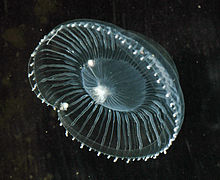
端足类分布在所有水生环境,由淡水至含有两倍盐份的海水也有。[2]它们是水生生态系统的重要组件。[11]大部分钩虾亚目物种都是浅水底栖的。𧊕亚目是浮游的。[3]很多都是与凝胶状动物,如水母、管水母目、放射虫及栉水母等具有共生关系,而大部分𧊕亚目的生命周期都会涉及这些凝胶状动物。[16]
一些击钩虾科是陆生的,栖息在潮湿的环境,如叶堆等。[17]它们的分布很广,包括属于以往冈瓦那大陆部分,与及部分欧洲及北美洲地区。
约有750种端足类是穴居的,分布在差不多所有适合的环境。它们的多样性中心在地中海盆地、北美洲东南部及加勒比地区。[18]
与其他甲壳类(如等足目)比较,端足类较少是寄生的。最著名寄生的端足类是鲸虱,它们是腹背扁平的,有强壮及很大的爪,用来将自己附在须鲸之上。它们是唯一寄生的甲壳类不懂游泳的。[19]
大部分端足类都是吃碎屑或食腐动物[2],另有一些是吃藻类、杂食性或掠食细小昆虫及甲壳类。[2][3]它们会用最前两对有爪的脚来抓食物吃。[2]
参考
[编辑]- ^ 引用错误:没有为名为
ITIS_93294的参考文献提供内容 - ^ 2.00 2.01 2.02 2.03 2.04 2.05 2.06 2.07 2.08 2.09 Sam Wade, Tracy Corbin & Linda-Marie McDowell. Class Crustacea. Critter Catalogue. A guide to the aquatic invertebrates of South Australian inland waters (PDF). Waterwatch South Australia. 2004. ISBN 1-876562-67-6. (原始内容 (PDF)存档于2009-10-17).
- ^ 3.0 3.1 3.2 3.3 3.4 3.5 3.6 Order Amphipoda. Guide to the marine zooplankton of south eastern Australia. Tasmanian Aquaculture & Fisheries Institute. 2008. (原始内容存档于2008-07-20).
- ^ 4.0 4.1 4.2 John R. Holsinger. What are amphipods?. Old Dominion University. [2010-04-07]. (原始内容存档于2011-07-20).
- ^ J. Laurens Barnard, Darl E. Bowers & Eugene C. Haderlie. Amphipoda: The Amphipods and Allies. Robert H. Morris, Robert Hugh Morris, Donald Putnam Abbott & Eugene Clinton Haderlie (编). Intertidal Invertebrates of California. Stanford University Press. 1980: 559–66. ISBN 0-8047-1045-7.
- ^ J. Laurens Barnard & Camilla L. Ingram. The supergiant amphipod Alicella gigantea Chevreux from the North Pacific Gyre. Journal of Crustacean Biology. 1986, 6 (4): 825–39 [2010-06-04]. (原始内容存档于2020-07-31).
- ^ T. Wolff. The fauna of Rennell and Bellona, Solomon Islands. Philosophical Transactions of the Royal Society of London. Series B, Biological Sciences. 1969, 255 (800): 321–43 [2010-06-04]. (原始内容存档于2020-06-10).
- ^ L. S. Peck & G. Chapelle. Reduced oxygen at high altitude limits maximum size. Proceedings of the Royal Society B. 2003, 270: S166–7. doi:10.1098/rsbl.2003.0054.
- ^ S. Pinkster. Redescription of Gammarus pulex (Linnaeus, 1758) based on neotype material (Amphipoda). Crustaceana. 1970, 18 (2): 177–186 [2010-06-04]. (原始内容存档于2020-05-03).
- ^ R. Vonk & F. R. Schram. Ingolfiellidea (Crustacea, Malacostraca, Amphipoda): a phylogenetic and biogeographic analysis. Contributions to Zoology. 2003, 72 (1): 39–72 [2010-06-04]. (原始内容存档于2013-12-03).
- ^ 11.0 11.1 J. K. Lowry & R. T. Springthorpe. Introduction. Amphipoda: Families. Australian Museum. [2010-04-05]. (原始内容存档于2006-02-21).
- ^ 12.0 12.1 Joel W. Martin & George E. Davis. An Updated Classification of the Recent Crustacea (PDF). Natural History Museum of Los Angeles County. 2001: 132 [2010-06-04]. (原始内容存档 (PDF)于2013-05-12).
- ^ Ko Tomikawa, Yoshimi Kawasaki, Alfonso Miranda Leiva and Nilton Deza Arroyo. 2023. Description of A New thermal Species of the Genus Hyalella from Peru with Molecular Phylogeny of the Family Hyalellidae (Crustacea, Amphipoda). Invertebrate Systematics. 37(4); 254-270. DOI: 10.1071/IS22060
- ^ Svenja Halfter; Charles Oliver Coleman; Chevreuxiopsis franki gen. n., sp. n. (Crustacea, Amphipoda, Thoriellidae) from the deep sea southwest of Tasmania. 2019
- ^ E. L. Bousfield & G. O. Poinar, Jr. A new terrestrial amphipod from tertiary amber deposits of Chiapas province, Southern Mexico. Historical Biology. 1994, 7 (2): 105–14. doi:10.1080/10292389409380448.
- ^ G. R. Harbison, D. C. Biggs & L. P. Madin. The associations of Amphipoda Hyperiidea with gelatinous zooplankton. II. Associations with Cnidaria, Cteuophora and Radiolaria. Deep-Sea Research. 1977, 24: 465–88. doi:10.1016/0146-6291(77)90484-2.
- ^ M. A. Minor & A. W. Robertson. Amphipoda. Guide to New Zealand Soil Invertebrates. Massey University. 2010-03-05 [2010-04-07]. (原始内容存档于2010-05-10).
- ^ Horton H. Hobbs, III. Crustacea. John Gunn (编). Encyclopedia of Caves and Karst Science (PDF). Routledge. 2003: 254–7 [2010-06-04]. ISBN 978-1-57958-399-6. (原始内容存档 (PDF)于2004-12-28).
- ^ Tim Goater. Parasitic Amphipoda. Interactive Parasitology. Vancouver Island University. 1996-05-04 [2010-04-07]. (原始内容存档于2010-07-14).

